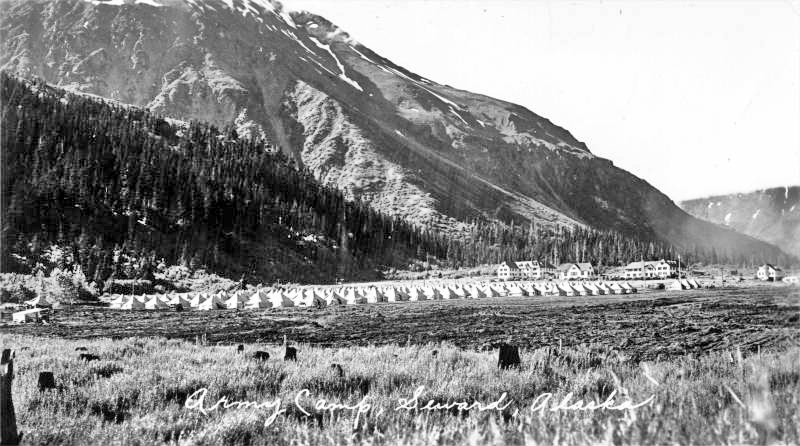
As Mary Berry wrote in her book Seward Alaska - A History of the Gateway City, on November 23 a fire erupted at 18 degrees with 30 MPH winds, one of the coldest days in early winter. The fire broke out around 11:30 pm and it took most of the downtown shops out. Most of the homeless went to stay at others homes, women and children went to the Jesse Lee Home and the men went to the roller rink and the lodge halls.
Scarcely a month after Pearl Harbor brought us into the war on 7 Dec 1941. The fears of the joining of forces between Germany and Japan and the proximity of the USSR and Japan had many Alaskans worried. Further with the war progressing the US government took note of the fast-spreading conflict and the potential danger of Japan to Alaska. This resulted in the earnest effort to fortify Alaska by the US Government.
As Seward was a major port for the state, John Paulsteiner from Post 5 described “The Second World War erupted and Seward turned from a sleepy town into a bustling seaport. Seward became the stronghold of the whole Pacific north of Seattle. Freight came here from Seattle, Portland, San Francisco and even Vladivostok in Russia. Thousands of tons of equipment and materials were transferred to Russian ships going to Vladivostok. Hundreds of crated airplanes went via the railroad to Fairbanks, were assembled there and flown by Russian pilots via Nome over Siberia and to the battlefronts. The work force of the shipside dockworkers increased from 30 to 164 men, The work went on 24 hours a day.”
As the war progressed the worked continued in Seward and the need for housing the incoming workers and soon to arrive troops was urgent. The sleepy town of Seward swelled in excess of 5000 troops in various infantry encampments at the newly established Fort Raymond and along the coast with coastal artillery battalions to be the outermost protection against Japanese aggression.
As the troops continued to grow and get settled, the NCOs of the 420 Coast Artillery Battalion built a log building for their recreational activities. This is the building the American Legion purchased after the war and still is the base form for the existing building of today.

Comments
Memorial Plaque for Tribute to All Veterans
From the May 29, 1946 Seward Polaris
MEMORIAL PLAQUE SUSTAINED
AS TRIBUTE TO ALL VETERANS
On Memorial Day we pause to pay tribute to our boys who fought for us in World War II – the boys whose names adorn our town’s memorial plaque. The beautiful blue and gold memorial which took its place last summer among Seward’s landmarks was made by Everett Hoy. On its roster are nearly all of our local boys who were called to the colors. Editor’s note: The plaque was installed behind the Federal Building (site of today’s City Hall) but is no longer there.
As we pass this memorial every day and sometimes as often as a dozen times a day, let us not forget that every boy named has served his country well. Two of the 134 listed sacrificed their lives for the cause. Some were badly wounded. Many are still in service.
But the majority of our Seward servicemen have received their discharge and have once more taken their place in our community affairs. In Seward the problems of housing veterans will be solved by the conversion of our 420th area Quonset huts into suitable temporary homes.
We are also indeed fortunate in that there is no unemployment problem here. An employment bureau for veterans has been established and is being handled capably by Mrs. Harry Southard, who is also clerk of the Land Draft Board. But nearly all of our local boys are now employed whether they obtained their jobs through the employment service or on their own.
The railroad and steamship company have absorbed the largest share of our ex-servicemen. A number of veterans have launched new enterprises. Others whose fathers have established businesses here have returned to lend their assistance. Several have returned to their [pre] war jobs.
MANY VETERANS AMONG NEWCOMERS
Not included on the memorial plaque but to be equally honored are our servicemen who were stationed at Fort Raymond and have stayed in Seward upon receiving their discharge and those who have since migrated here to establish businesses and to lend their time and talents to building our post war community.
There is Glen McCreary who was stationed at Fort Raymond and was an official Alaska Department Signal Corps photographer. Glen has bought the interests of Mrs. Dean Bedford in the Glacier Photo Shop and offers an excellent photographic service to the town…
Charles Haney from Anchorage has established the Gateway Radio Repair Shop and is making plans to establish a radio station here at some future date, possibly this summer.
Ed Burke in partnership with Ray Lee leased Ogle’s Garage and is building up a fine automobile repair business.
“Whitie” Barnett is a crew member in one of Heinie Berger’s F.S. boats which will make the Seattle to Seward run. Burt Walker and Carl Sparks are operators for the city-owned light plant.
Phil Allard is employed with the Forestry Service stationed at Kenai Lake Ranger Station. John Cunningham is employed with Alaska Railroad and is working on the dock. Both of these boys are sons of Mrs. Phil Harding of Mom’s Diner.
Gilbert Youngblood who was stationed at Fort Raymond is returning here from his home in Virginia to settle and marry one of the local girls, Frances Hoogland.
Ray Markovich, nephew of Tony Parich, since his release from service with the Combat Engineers is making his home here assisting his uncle at his newly opened bar.